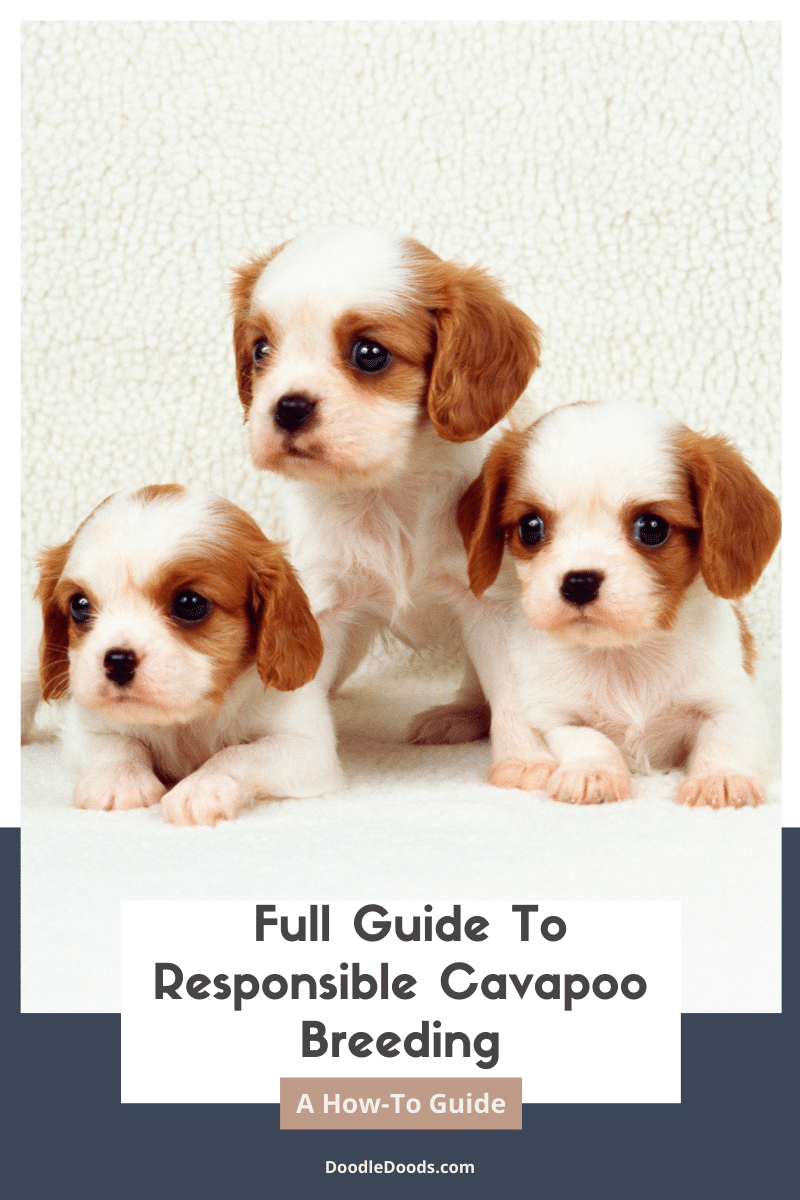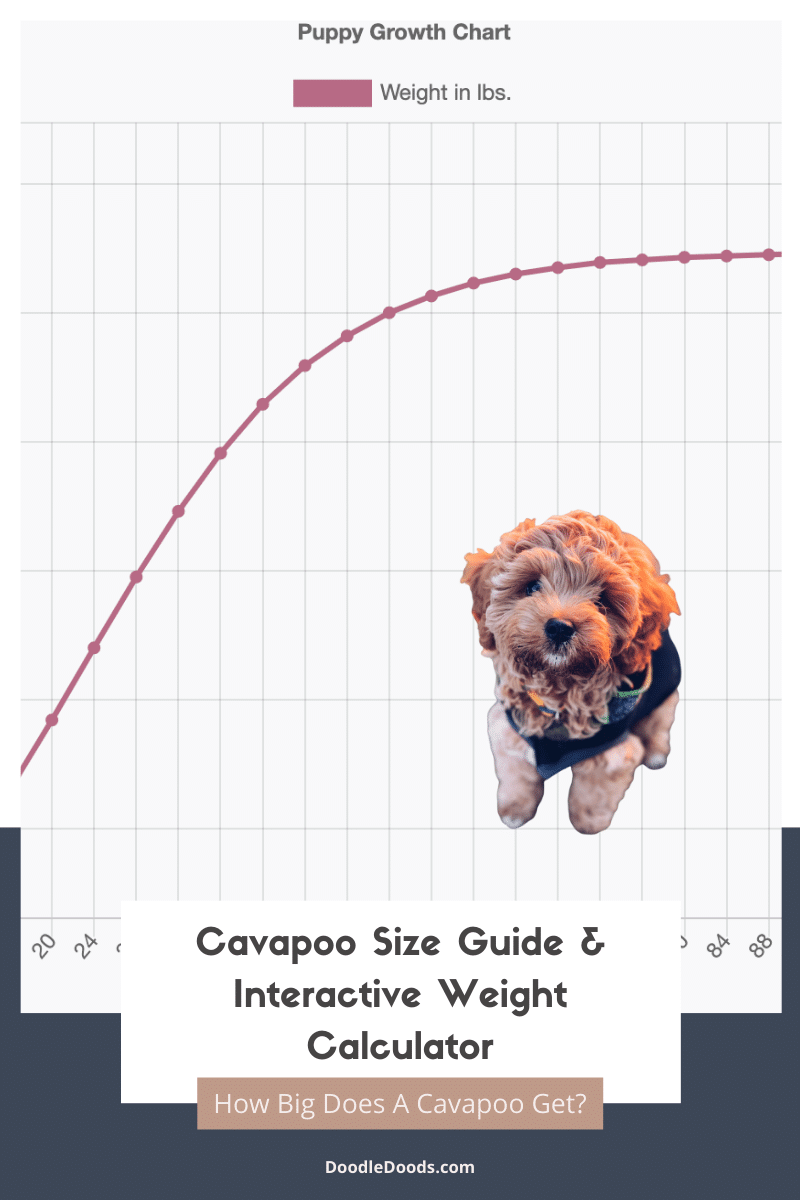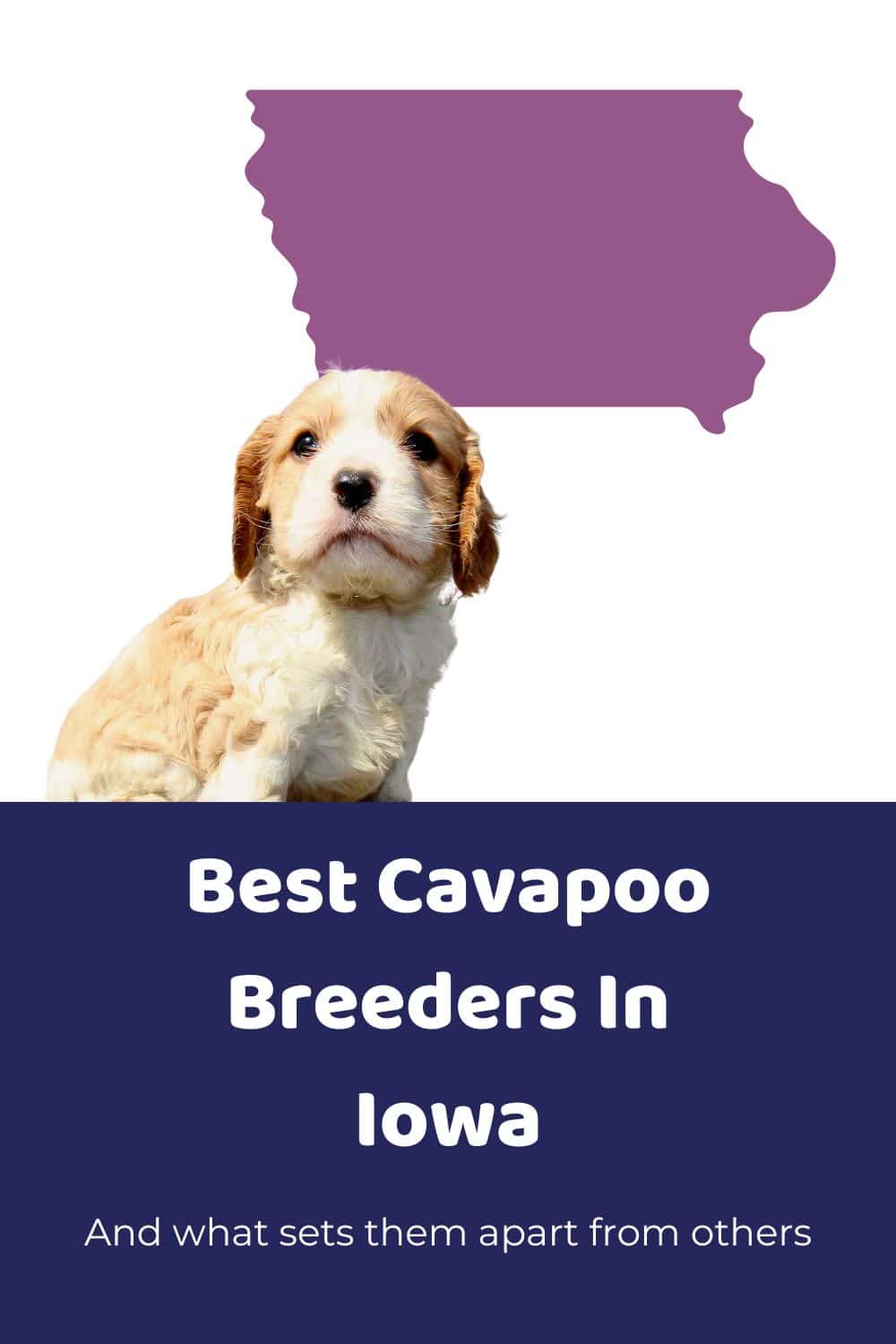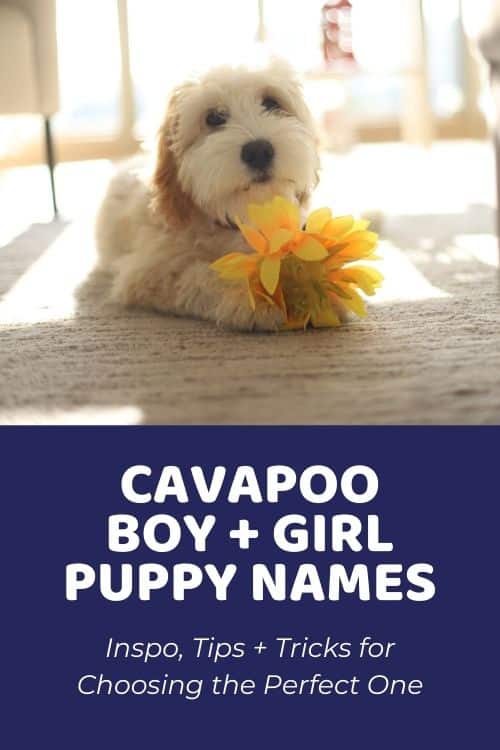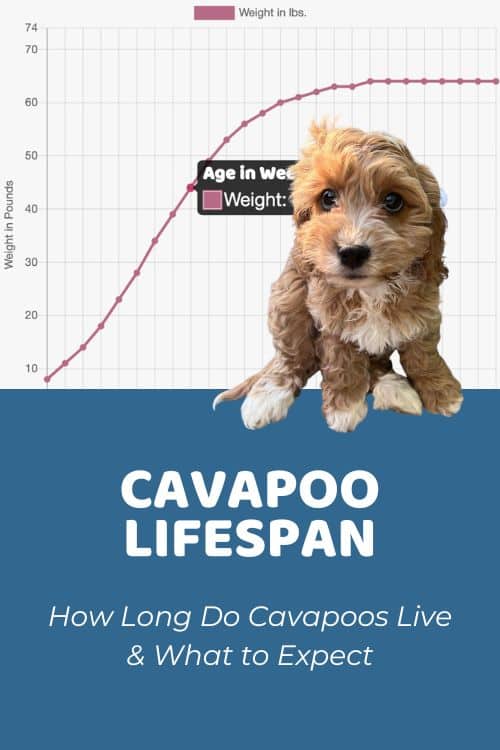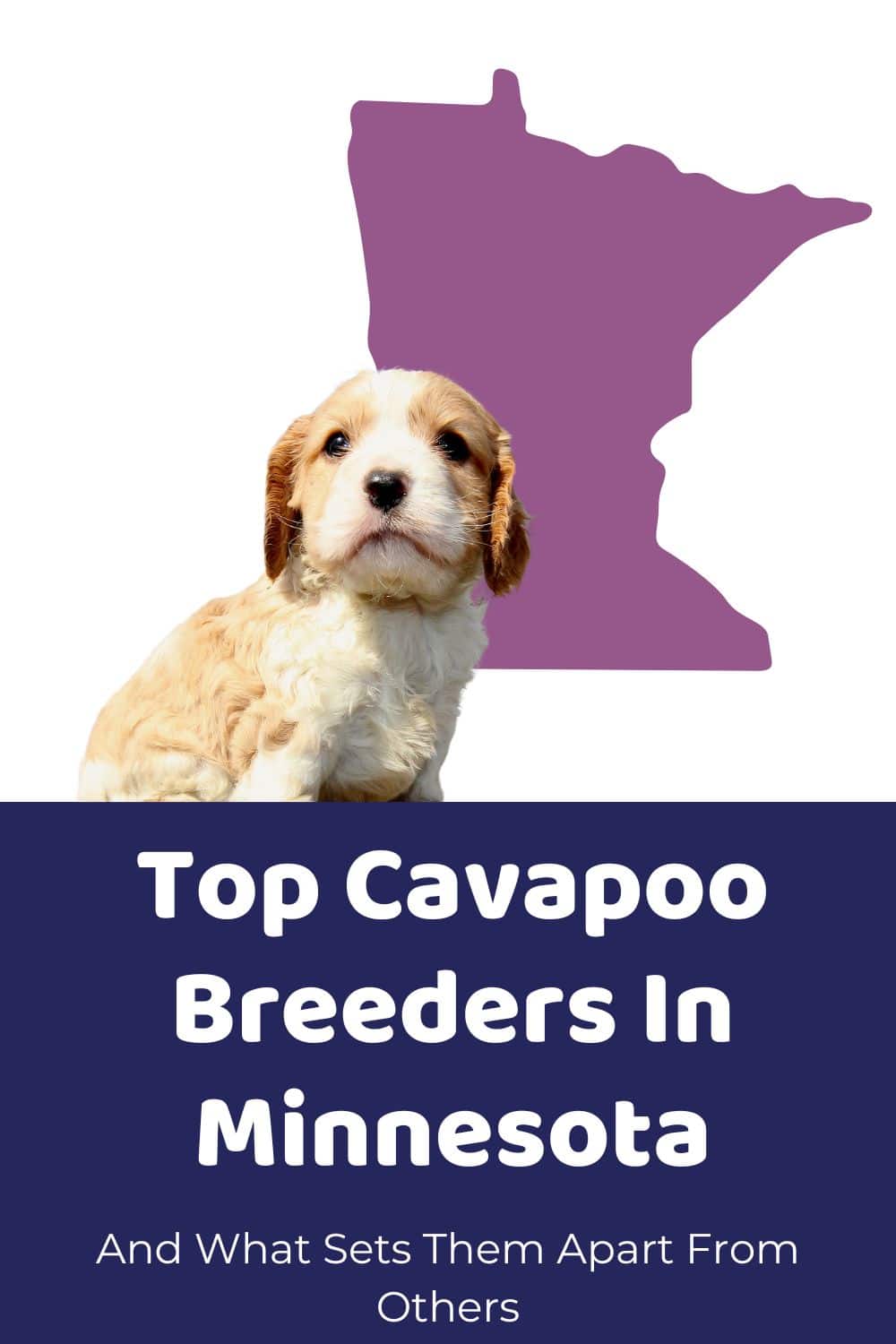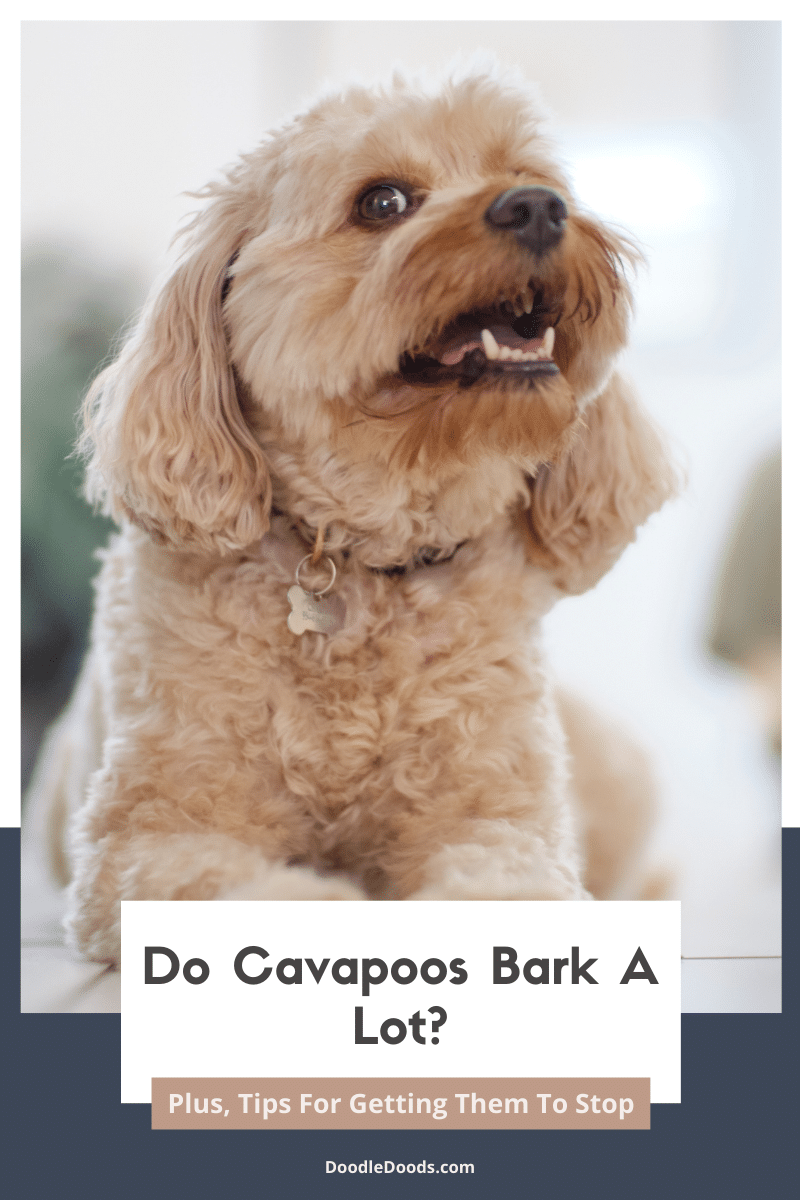Cavapoos, that wonderful cross between the cute, quirky Cavalier King Charles Spaniel and the athletic, hypoallergenic Poodle, are truly delicious dogs. In fact, they are one of the most popular of the dinkier Doodles. Owners of these precious pups are often so taken with their charms that they may consider breeding their own litter of Cavapoos. If that’s you, and you’re thinking of getting into the Cavapoo breeding game – whether just as a one-off or on a more ongoing basis, there are a few things you’ll need to know ahead of time. Here we’ll cover some of the more critical details of dog breeding, such as health testing, picking out a suitable mate, and caring for mama and her puppies when they arrive.
Table of Contents
- Dog Breeding: A Quick Word of Caution
- Cavapoo Breeding Checklist
- 1. Health & Genetic Screening
- 2. Generations & Sizes
- 3. Federal Licensing & USDA Standards
- 4. Choosing A Suitable Mate
- 5. Breeding & Pregnancy Care
- 6. Setup, Equipment, & Supplies
- 7. Birthing, Rearing The Puppies & Weaning
- 8. Training, Socialising & Extra Services
- 9. Advertising The Puppies & Social Media
- 10. Following Up With The Families
Dog Breeding: A Quick Word of Caution
Becoming a Cavapoo breeder can be a deeply satisfying career choice for a serious animal lover. However, don’t be lulled into thinking that it’s a straightforward process. There is A LOT to think about both before and after the (ahem) essential act. While anyone can put two dogs together and hope for the best, if you’re looking to breed healthy puppies that go on to find loving homes, you’re going to have to put a bit of work into it.
Backyard breeders (people breeding pets) are an all-too-common issue. While not quite as bad as the dreaded puppy mills where dogs are bred for profit, they are as harmful, in their own way, to the breeding industry and Cavapoos in general. The biggest reason for this is simple lack of knowledge. Just because a dog seems healthy does not mean they will produce a healthy litter. That’s why knowing about genetic testing, for a start, is crucial.
Beyond that, anyone looking to get into Cavapoo breeding needs to understand what an intense commitment it is – in terms of both time and money. Much research is required on breeding best practices as well as Cavapoo sizes and generations. You’ll have to shell out for various health tests to ensure your breeding animals don’t pass on anything nasty to the puppies, and that’s before all the hard work of puppy rearing has even begun!
Cavapoo Breeding Checklist
If you feel like you have a reasonably decent understanding of what it takes to be a Cavapoo breeder and are ready to get going with the research, here’s our checklist of where to start:
1. Health & Genetic Screening
As experts over at the American Kennel Club (AKC) put it, “The motto of the responsible breeder … is ‘Breed to Improve.’” While they limit this to purebred dogs, we would say it’s a valid statement for anyone looking to breed any kind of dog… or any kind of animal at all, for that matter. The first step in looking to improve the overall Cavapoo line is to ensure that the dogs you are breeding are in the very best health – both physically and genetically.
The logic behind the physical part is obvious, especially when it comes to the mother pup. Pregnancy and nursing is a physically demanding business, and you’ll need to ensure your pet is up to it. In terms of genetics, many of the most common canine health conditions (hip dysplasia, patella luxation, atopic dermatitis) are passed along from one generation to the next. You’ll need to be sure your breeding dogs don’t carry the genes for these.
2. Generations & Sizes
While breeding purebred dogs focuses on ensuring they live up to the physical standards of that breed, when it comes to genetics, things are even more complicated for a Doodle breeder. There is not one single type of Cavapoo. In fact, there are multiple varieties, and each one brings something different to the table. This is something you’ll need to be well read up about because your buyers will likely have a lot of questions.
The first thing to know is that Cavapoos come in two distinct sizes depending on the Poodle (or Poodles) used in their creation. The Mini Cavapoo is the larger of the two at between 3 to 25 pounds and 12 to 16 inches to the shoulder. The Toy Cavapoo is smaller at 7 to 13 pounds and 9 to 12 inches to the shoulder. Smaller dogs tend to be more popular, so the Toy Cavapoo is likely more in demand, but the flip side is that they aren’t always as healthy, so you will need to take more care with their breeding.
Once you’ve got a handle on that, you’ll need to dive a little deeper into Doodle generations. Basically, there are three of these (F1, F2, F3) based on the breed of the parent pups. First-generation (F1) Cavapoos have one of each breed, whereas successive generations (F2 and F3) are bred from Cavapoos. Sometimes litters are even backcrossed with purebred Poodles. These are termed F1B, F1BB, F2B, and F2BB.

The reason for this variation is that the different generations have varying amounts of Spaniel and Poodle genes. As Doodles originally came about to allow those with pet allergies to experience the joys of dog ownership and are still much lauded for their ‘hypoallergenic’ properties, many breeders focus on ensuring they inherit that low-shed Poodle coat. Introducing more Poodle genes into the equation makes this more of a possibility. Cavapoo breeding is complex!
3. Federal Licensing & USDA Standards
Depending on what you’re looking to get out of breeding Cavapoos, you may or may not need to register as a breeding facility. Typically, as per the U.S. Department of Agriculture (USDA), if you own more than four female breeding dogs and you sell the puppies sight unseen, then you may be subject to their licensing procedures and regulations. Also, these rules can vary from place to place.
A further consideration when thinking about standards and licensing is that most people looking to buy a puppy are more likely to trust a facility that is regulated in some way. With regards to Doodles, plenty of voluntary organizations are popping up across the country with the aim of making breeding better. Good Dog is one of the more popular examples. Breeders can register with the organization and, after a careful screening process, become affiliated with them. Doing this indicates to buyers that the facility breeds puppies of a higher standard than other unregistered breeders.
4. Choosing A Suitable Mate
Unless you own a breeding pair of pups, you’ll need to find someone with a compatible dog to do the deed. While you may be interested in color, coat type, or even temperament, again, it’s health that really needs to take priority here. Not only should both breeding animals be health tested, but they also require “conditioning” to produce the best offspring. This includes everything from regular vet checks to regular exercise and good nutrition.
The female especially needs to be in tip-top condition – both physically and mentally. She must be of a healthy size and weight, with decent muscle tone and a non-anxious character. And she should be vaccinated and treated for parasites ahead of breeding. As female dogs are only to be bred at specific times, you’ll have to pay close attention to her estrus cycle to understand when she is fertile and will actually accept the attention of a male dog.
If you are looking to find a suitable match, be sure you are clear on his bloodline. What generation does he belong to (if he is a Cavapoo)? What coat type does he have? What size is he? This is important for understanding more about what to expect from the puppies. You’ll also want to have knowledge of the dog’s temperament. Avoid dogs that are overly shy, anxious, or demonstrate aggressive tendencies that could be passed on to the litter.
5. Breeding & Pregnancy Care
Once you have narrowed down the fertility window, it’s time to get the job done. You’ll have found the right breeding dogs and negotiated a stud contract as needed. You’ll have avoided the female dog’s first season to not put undue stress on a growing pup, and you’ll be ready to go. You’ll usually take the female to the male. Be sure to read up on what to expect from this process so you’re not alarmed by the “breeding tie,” for instance.
Afterward, keep a close watch for early signs of pregnancy. These include increased appetite, weight, and genital and nipple size. You won’t, however, be able to confirm with the vet until at least 28 days later. Following this, you’ll need to rethink how you’re currently caring for your pet. Switching her to a food specifically for pregnant dogs is a good start. Just take care not to overfeed her, as obesity can complicate the birthing process.
Exercise plays an integral part in the ongoing health and wellness of your dog at this time. You’ll want to continue walks as usual until she starts to get a little bigger. After this, be sure to stick to gentle exercise such as regular strolls in the park and light play. If you notice that your dog becomes very tired after her regular length walks, you might try taking her for shorter ones more frequently. Each dog is individual, so let her guide you with this.
6. Setup, Equipment, & Supplies
Alongside food for the mom and her puppies, there are a few other purchases you’ll need to make ahead of time. Firstly you’ll need a whelping box. Have it all set up and ready to go in good time to get your dog used to spending time in it. This helps to ensure that when the time comes, she picks this location to birth her puppies and not somewhere you really don’t want her to. Be sure the box is roomy enough for her to move about in but not so big that the puppies can move too far away from her and cannot access food easily.
To line this box, you’re going to need something absorbent yet easy to clean. Towels and blankets are a must – newspaper too. You’ll also need whelping supplies, including a thermometer, hemostat, gloves, stethoscope, bulb syringe, disinfectant, a scale, and something to record the puppies’ birth weight, color, and sex. As puppies struggle to regulate their temperature in those first few weeks, you may also need to invest in heating pads to keep them warm. Don’t forget to pick up some suitable puppy food too!
7. Birthing, Rearing The Puppies & Weaning
Canine pregnancy typically lasts around 63 days, give or take a week, depending on the number of puppies expected. Knowing your dog’s due date will mean you are fully prepared when the time comes. It’s also good to keep your eyes peeled for early signs of labor. These include loss of appetite and a more active attempt at nesting. When the time does come, let your dog take care of business as much as possible but keep an eye on her throughout the process to be sure everything is going as it should.
In fact, if you can organize an experienced breeder to oversee the first whelping, you should. This will not only help to put your mind at rest about what’s going on, but it will also ensure that all goes smoothly. Have the emergency number of your vet to hand in case complications arise. Whelping can last somewhere in the region of 3 to 12 hours, so be prepared to be there for a while!
Once the puppies are born, handle them as infrequently as possible. The mother should take of the rest. Just be sure that the puppies are feeding and keeping warm. That’s all you really need to do in the first few days. Then, as the puppies start to grow, pay close attention to their weight gain to see that they are maturing at the correct rate. Weaning will begin somewhere between two to four weeks of age. At this time, you will introduce the puppies to high-quality, specifically-formulated-for-puppies food.
8. Training, Socialising & Extra Services
Aside from keeping careful watch over mom and puppies and weaning them when it’s time, you’ll also have to think about vaccinations and deworming treatments. From three weeks in, you’ll also be looking to start socializing the puppies and getting them accustomed to the world around them. You’ll begin to introduce them to everyday household sights and sounds and handle them as often as possible. You might also look into early neurological stimulation (ENS).
Consider that any buyers interested in your puppies will look up to you as a dog expert – especially of Cavapoos, so advance your knowledge on all things canine when you can. Newbie owners may have questions on early issues such as potty or crate training. Some breeding facilities go so far as to include basic training as part of the service, either by offering basic potty training while they are there or keeping the puppies a little longer to get them into a routine. This might be something to consider.
9. Advertising The Puppies & Social Media
Don’t wait until the puppies are born to get the word out about them. Setting up a company website is a good idea if you want to establish a breeding business. Beyond that, you’ll also want to look into having dedicated Instagram and Facebook pages. Here you can post photos, videos, and updates of the parents and puppies, and people who have purchased previous litters can leave testimonials and pictures of the growing dogs.
The benefit of all this is that prospective buyers can easily find you, and it also works to build your reputation in the Cavapoo breeding community. These days, with the rise of scammers, people are more cautious than ever about whom they interact with. You’ll need to spend a fair bit of time setting up your online presence, adding details about the parent pups, such as their genetic heritage and the kinds of genetic tests you have administered.
10. Following Up With The Families
While finding your puppies the best possible homes will be high on your agenda, your responsibility towards them doesn’t end there. Many breeders provide guarantees with their puppies to demonstrate their confidence in their animals’ health. These can last anywhere between 72 hours and two years and state that you will take the puppy back and provide a full refund if any genetic issues arise. Obviously, the longer the guarantee, the more trustworthy your facility will seem.
Beyond that, be prepared to address any follow-up questions buyers may have about their puppies – everything from the right kind of food to feed them to how to care for their coats. The more you are ready and prepared with information regarding Cavapoo breeding, as well as resources, training tips, and product recommendations, the more your business reputation will grow. Satisfied customers are also more likely to leave glowing reviews on your social media.
If you are thinking of getting into the dog breeding industry – specifically Cavapoo breeding, there are some important things to know. You’ll need to have a good understanding of how the genetics of these dogs play out, purchase the right equipment to be fully prepared for whelping and weaning, and you’ll need to be ready to fully invest in your puppies and their future too. Hopefully, the details included here have given you an idea of areas to work on when setting yourself up in the right way as a Cavapoo breeder.
Learn How to Care for Your Doodle Puppy!

Perfect for first-time Doodle parents, get ALL your questions answered, including questions new Doodle parents don’t even think to ask.
Plus, get $700 worth of Bonus Materials for FREE, including:- Doodle Parenthood Community and Support Group ($190 value)
- Doodle Puppy Growth Tracker ($20 value)
- EMERGENCY Cheatsheet: When To Call The Vet Immediately ($50 value)
- HELP! Button ($145 value)
- And SO MUCH MORE!

